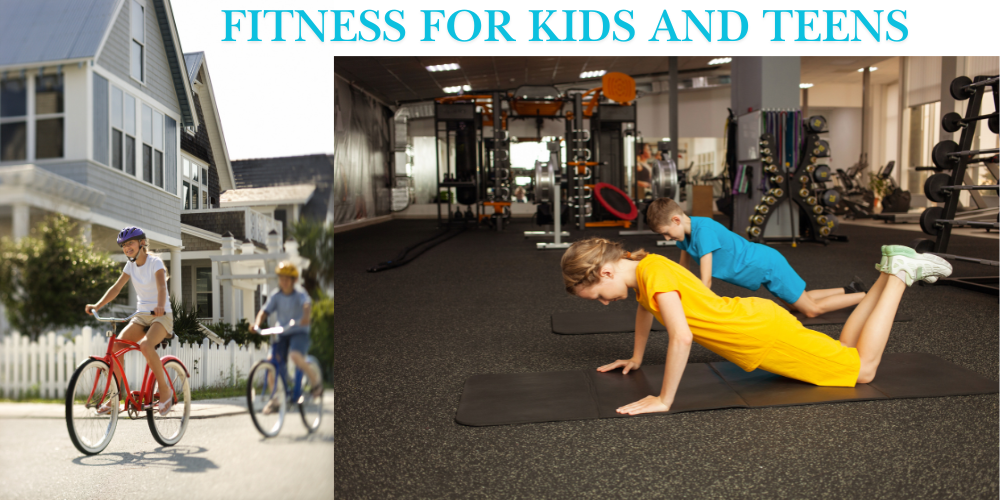Given all of the screens and the still sedentary life we’re living today, getting kids and teens with active lifestyles is more important than ever. As this article makes clear, childhood and adolescence serve as vital windows of opportunity for the adoption of healthy habits that are likely to endure into adulthood. Not only does promoting fitness help children to remain at a healthy weight, but it also provides a huge range of mental, physical, and emotional benefits. In this blog post, we turn our focus to the significance of fitness for kids and teens, practical ways to promote active lifestyles that last, and ways to make exercise not just enjoyable but fun.
The Importance of Fitness for Kids and Teens
Regular physical activity is necessary for the health of children and adolescents. Here are some key benefits:
- Physical Health:
- Healthy Weight: Exercise keeps the body in shape by burning muscle mass and keeping a healthy weight.
- Stronger Bones and Muscles: Physical activity strengthens bones and muscles, improving posture, coordination, and overall physical function.
- Reduced Risk of Chronic Diseases: Kids who exercise have a much higher risk of developing (future) chronic diseases such as heart disease, type 2 diabetes, and a few varieties of cancer.
- Improved Cardiovascular Health: Regular exercise can help keep your heart healthy and boost blood flow.
- Enhanced Sleep Quality: Daily exercise has been shown to help you have more restful sleep.
- Mental and Emotional Well-being:
- Reduced Stress and Anxiety: Exercise is a great stress reliever! It helps release endorphins, which have mood-boosting effects.
- Improved Self-Esteem: Achieving fitness goals and mastering new skills can boost confidence and self-esteem.
- Better Concentration and Focus: Physical activity can enhance cognitive function, attention span, and academic performance.
- Socialization and Teamwork: Engaging in sports and group activities promotes social interaction and teamwork skills.
How Much Exercise is Enough?
As recommended by the World Health Organization (WHO), adolescents and children aged 5-17 should engage in moderate to vigorous-intensity physical activity for at least 60 minutes each day. This activity should involve muscle and bone strengthening, and it should be done at least three days a week.
Making Fitness Fun and Engaging
The key to encouraging a lifelong love of fitness is to make it enjoyable! Here are some strategies to spark enthusiasm for physical activity in kids and teens:
- Variety is Key: Offer a vast variety of activities to keep things interesting. Mix it up with team sports, individual pursuits, outdoor adventures, and dance classes.
- Focus on Fun, Not Competition: Emphasize the joy of movement and playing rather than winning or losing.
- Incorporate Play: Encourage unstructured playtime outdoors. It allows for creativity, exploration, and the development of essential motor skills.
- Be a Role Model: Children learn by example. Make physical activity a part of your own life and involve your kids in your workouts.
- Set Realistic Goals: Begin with small achievable goal options and gradually add time and level of intensity over time.
- Limit Screen Time: Set reasonable limits on screen time and encourage active alternatives.
- Make it Social: Encourage participation in team sports or group activities to foster a sense of camaraderie and support.
- Celebrate Achievements: Recognition of their effort on each milestone achieved, irrespective of its size. Evaluate the significance of their minor achievements.
Age-Appropriate Activities
- Preschoolers (3-5 years): Focus on active play that develops fundamental movement skills. Think running, jumping, throwing, catching, and climbing.
- Children (6-9 years): Continue to encourage unstructured play, introduce structured activities like swimming, biking, and martial arts, and consider team sports.
- Pre-teens and Teens (10-17 years): Offer a wider variety of activities, including fitness classes, team sports, individual sports (tennis, track and field), dance, and outdoor adventures like hiking and kayaking.
Tips for Parents and Caregivers
- Create an Active Environment: Limit screen time, provide access to sports equipment, and encourage outdoor play.
- Be Supportive: Offer encouragement positive feedback, and celebrate their efforts. Avoid criticism or pressure.
- Please make it a Family Affair: Plan active outings like trips to the park, hikes, and bike rides.
- Consult a Healthcare Professional: If you are concerned about your child’s health or fitness level, confer with a qualified healthcare professional or their doctor.
- Listen to Your Child: Pay attention to your child’s interests and preferences. Please don’t force them into activities they don’t enjoy.
- Be Patient: Developing healthy habits takes time. Be supportive and patient as your child explores different activities and finds what they enjoy.
Incorporating Fitness into Everyday Life
- Walk or Bike to School: Encourage your child to walk or bike to school instead of relying on transportation.
- Take the Stairs: Skip the elevator and opt for the stairs whenever possible.
- Active Chores: Involve kids in active chores like gardening, raking leaves, or walking the dog.
- Commercial Break Workouts: During TV commercial breaks, encourage kids to get up and move with jumping jacks, push-ups, or dancing.
- Park Farther Away: When running errands, park farther away from the entrance to increase walking time.
Conclusion
Promoting fitness in kids and teens is an investment in their present and future health. By creating a supportive environment and making physical activity fun and engaging, we can empower young people to embrace active lifestyles and reap the numerous benefits of regular exercise. Let’s inspire the next generation to move, play, and thrive!
Disclaimer
The information given in this blog post is for general purposes only and should not be taken as medical advice. Be sure to confer with a qualified healthcare professional before beginning any new exercise program or if you have any questions about your child’s health or fitness level.


